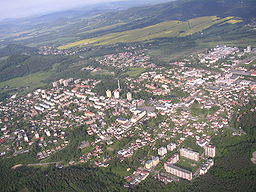Nový Bor
| Nový Bor | |
| Town | |
|
Aerial picture of Nový Bor
|
|
| Country | Czech Republic |
|---|---|
| Region | Liberec |
| District | Česká Lípa |
| Commune | Nový Bor |
| Elevation | 365 m (1,198 ft) |
| Coordinates | 50°45′19″N 14°33′13″E / 50.75528°N 14.55361°ECoordinates: 50°45′19″N 14°33′13″E / 50.75528°N 14.55361°E |
| Area | 19.94 km2 (7.70 sq mi) |
| Population | 11,992 (1. Jan. 2014) |
| Density | 601/km2 (1,557/sq mi) |
| First mentioned | 1692 |
| Mayor | Jaromír Dvořák |
| Timezone | CET (UTC+1) |
| - summer (DST) | CEST (UTC+2) |
| Postal code | 471 18 - 473 01 |
| Statistics: statnisprava.cz | |
|
Website: www |
|
Nový Bor (Czech pronunciation: [ˈnoviː ˈbor]; German: Haida) is a town in the Liberec Region of the Czech Republic. From 1938 to 1945 it was one of the municipalities in Sudetenland. It has about 12,000 inhabitants. There is developed production of glass artifacts, small precision motors and, increasingly, tourism.
The town is placed between Lusatian Mountains (Lužické hory) and Central Bohemian Uplands (České středohoří). First written document mentions this place in 1471 as village Arnsdorff (Arnultovice). During 17th and 18th century this place slowly grew into small town. In 1757 it got elevated into status of city, which was called Haida. In 1783 engineer Emanuel Kleinwächter had created plan for the new city with lots of gardens and city green. Since end of 18th century Nový Bor became known for its high concentration of glass industry (as happened in the whole region).
The town is located on the edge of a mountainous region, which influences the local climate. Average annual temperatures vary from 5 to 7 °C and the annual rainfall is also relatively high at 800 to 1000 mm. The area gets a fair bit of snow in the winter, especially north of the town, in the mountains, making it a popular destination for cross country and downhill skiing. Large parts of the area are covered with forests, unfortunately the original mixed deciduous forests have been largely replaced with evergreen pine monocultures over the last few hundred years.
The town is sought after for its natural scenery and extensive forests in summer as well as winter. Hiking, cycling and cross-country skiing in the winter are made pleasant by many well marked tourist trails as well as many pubs, camps and B&B. The city dominant is the mountain Klíč (759 m), offers panoramic views over a large part of Northern Bohemia, all the way to Germany and Poland on the North and Krkonoše mountains in the east to almost the outskirts of Prague in the south.
...
Wikipedia


